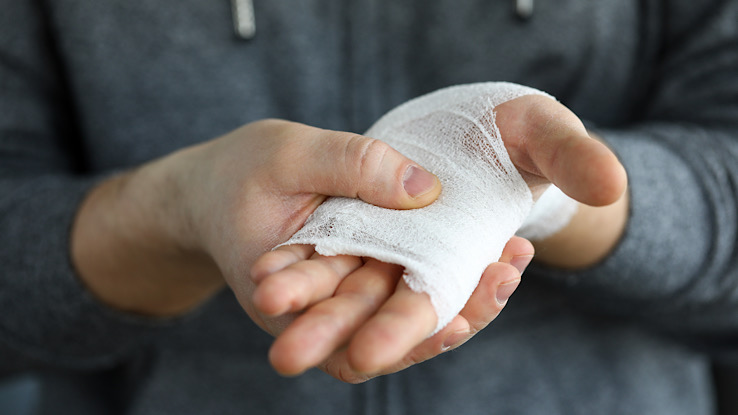Funny Cross Stitch Funny Cross Stitch

Not sure if your cut is bad plenty for stitches? Read our handy guide to stitches, which includes information on knowing whether you need stitches and what could happen if you decide not to get them.
Stitches using different kinds of threads. Rows of stitches holding together the edges of a wound are called sutures, and sutures can be made of nylon, silk, or vicryl.
Stitches can:
- Close wounds or cuts
- Preclude further blood loss
- Minimize scarring
Not all wounds require stitches; however, they can be beneficial in protecting against infection for more than astringent cuts.
Showtime, you should call nine-1-1 immediately if you are experiencing uncontrolled haemorrhage.
The post-obit iii factors about your cut will assist a dr. decide whether y'all need stitches:
Depth
Wounds more than ¼-inch (6 millimeters deep) ordinarily need stitches. If you can run into yellowish fatty tissue in your wound, that's a sign that it is deep enough to require stitches.
Width
Gaping wounds or wounds that cannot be closed quickly about always require stitches. If your injury has jagged edges, you should also check to meet if you need stitches.
Location
If your cut is in an surface area of your skin that moves and stretches often, you might demand stitches. An example is a wound that is on or most a articulation.
In add-on to these rules, those who have diabetes or accept an beast bite should e'er see a doctor, even if their wound seems like information technology might non demand stitches.
What To Expect
Your md will examine your cut to see if stitches are essential. If they are, the dr. will first disinfect your wound and clean the surrounding area of the skin to prevent infection. So, the physician will ready the sutures much like someone prepares a needle and thread to sew. Finally, the physician creates a looping pattern from 1 cease of the cut to close the wound.
In most cases, your dr. will use a local anesthetic and so that this process is relatively painless. The coldhearted may be a numbing gel spread onto the skin or a liquid injection near the site of the wound. Y'all will non feel pain with a local anesthetic, but you lot may feel a tugging at the pare as the doctor threads in the stitches. For severe wounds requiring many stitches, the dr. will use a general anesthetic and so that y'all are unconscious throughout the procedure.
Later Stitches
Always follow your doc's instructions for caring for your stitches. Most need to stay dry for a twenty-four hour period or 2. An antibiotic ointment and bandage are usually practical to foreclose infection, and you will demand to change these dressings at least one time a day. If a run up pops open or the wound becomes swollen or oozes pus, see your doctor.
Your stitches volition stay in identify until your skin has healed. The length of time it takes to recover will depend on the severity of the wound. A doctor tin remove the stitches with tweezers once the healing is consummate. You may also go a pare ointment that you can utilise once the stitches are out to help minimize scarring. One exception to this is when your stitches are with vicryl sutures. Vicryl is a blazon of thread that dissolves in the pare, meaning that you won't need to go back to the md to get your stitches removed.
Possible Risks Of Fugitive Stitches
If you need stitches, information technology'due south essential to make clean and cover your wound and see a doctor every bit soon equally possible. You can get stitches in an emergency room or urgent care clinic. In most cases, y'all have about 6 to viii hours to get stitches before the wound is also contaminated to run up up. Fugitive stitches for a astringent cut could lead to the following complications:
- Tenderness virtually the wound
- Inflammation near the wound
- Numbness well-nigh the wound
- Red streaks almost the wound
- Scarring
- Fever
- Serious infection
Finally, don't forget that you should run across a doctor no thing what if there'due south a chance that y'all could go tetanus. This severe infection can result from any cutting if yous haven't had at to the lowest degree iii tetanus vaccinations, with the most recent occurring within the final five-x years.
Stitches tin be annoying, but they are usually the best affair for ensuring that you don't get an infection and that your wound heals correctly. Always ask a doctor for guidance if you're unsure whether you need stitches.
Resource Links:
- "Wound Closure Techniques" via StatPearls
- "Comparing sutures versus staples for pare closure subsequently orthopaedic surgery: systematic review and meta-assay" via BMJ
- "Human tissue reaction to sutures" via Register of Surgery
- "Cutaneous Wound Closure Materials: An Overview and Update" via Journal of Cutaneous and Aesthetic Surgery
- "The function of sutures and fibrin sealant in wound healing' via Surgical Clinics of North America
Source: https://www.symptomfind.com/healthy-living/when-to-get-stitches-everything-you-need-to-know?utm_content=params%3Ao%3D740013%26ad%3DdirN%26qo%3DserpIndex